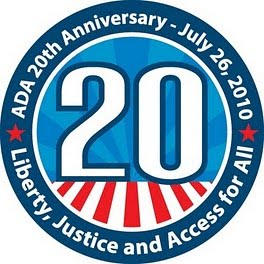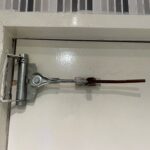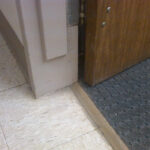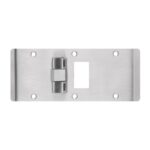 It’s hard to believe that last week was the 20th anniversary of the Americans With Disabilities Act. I clearly remember being sent to a seminar at the Ramada Inn in the early 90’s to hear all about how this *new* law would affect architecture and construction. Of course, not much of the presentation was spent discussing the hardware requirements, so our industry was left to figure it out over the years.
It’s hard to believe that last week was the 20th anniversary of the Americans With Disabilities Act. I clearly remember being sent to a seminar at the Ramada Inn in the early 90’s to hear all about how this *new* law would affect architecture and construction. Of course, not much of the presentation was spent discussing the hardware requirements, so our industry was left to figure it out over the years.
At one of last week’s anniversary celebrations, President Obama announced new rules for the enforcement of the ADA, including the adoption of the 2010 ADA Standards for Accessible Design. The 2010 ADA Standards for Accessible Design consist of the 2004 ADAAG and the requirements contained in Subpart D of 28 CFR part 36 (you can read Subpart D in the revised regulations below if you’d like to). The final rules will take effect 6 months after they are published in the Federal Register (as of today, they have not yet been published), and for the first 18 months, either the original 1994 ADAAG or the 2010 ADAAG may be used.
For door-related requirements, the 2010 ADAAG is very similar to ICC/ANSI A117.1. The standards have also been “harmonized” with the Architectural Barriers Act standards and the model codes. There are a couple of changes from the original ADAAG mentioned in Appendix B – Analysis of the 2010 ADA Standards:
404 Doors, Doorways, and Gates
Automatic Door Break Out Openings. The 1991 Standards do not contain any technical requirement for automatic door break out openings. The 2010 Standards at sections 404.1, 404.3, 404.3.1, and 404.3.6 require automatic doors that are part of a means of egress and that do not have standby power to have a 32-inch minimum clear break out opening when operated in emergency mode. The minimum clear opening width for automatic doors is measured with all leaves in the open position. Automatic bi-parting doors or pairs of swinging doors that provide a 32-inch minimum clear break out opening in emergency mode when both leaves are opened manually meet the technical requirement. Section 404.3.6 of the 2010 Standards includes an exception that exempts automatic doors from the technical requirement for break out openings when accessible manual swinging doors serve the same means of egress.
Maneuvering Clearance or Standby Power for Automatic Doors. Section 4.13.6 of the 1991 Standards does not require maneuvering clearance at automatic doors. Section 404.3.2 of the 2010 Standards requires automatic doors that serve as an accessible means of egress to either provide maneuvering clearance or to have standby power to operate the door in emergencies. This provision has limited application and will affect, among others, in-swinging automatic doors that serve small spaces.
Commenters urged the Department to reconsider provisions that would require maneuvering clearance or standby power for automatic doors. They assert that these requirements would impose unreasonable financial and administrative burdens on all covered entities, particularly smaller entities. The Department declines to change these provisions because they are fundamental life-safety issues. The requirement applies only to doors that are part of a means of egress that must be accessible in an emergency. If an emergency-related power failure prevents the operation of the automatic door, a person with a disability could be trapped unless there is either adequate maneuvering room to open the door manually or a back-up power source.
Thresholds at Doorways. The 1991 Standards, at section 4.13.8, require the height of thresholds at doorways not to exceed 1/2 inch and thresholds at exterior sliding doors not to exceed 3/4 inch. Sections 404.1 and 404.2.5 of the 2010 Standards require the height of thresholds at all doorways that are part of an accessible route not to exceed 1/2 inch. The 1991 Standards and the 2010 Standards require raised thresholds that exceed ¼ inch in height to be beveled on each side with a slope not steeper than 1:2. The 2010 Standards include an exception that exempts existing and altered thresholds that do not exceed 3/4 inch in height and are beveled on each side from the requirement.
Resources:
2004 (now 2010) ADA-ABA Accessibility Guidelines for Buildings and Facilities
Revised Title III Regulation
Fact Sheet: Highlights of the Final Rule to Amend the Department of Justice’s Regulation Implementing Title III of the ADA
Appendix B to Part 36 – Analysis and Commentary on the 2010 ADA Standards for Accessible Design
ADA/ABA Standards – Which facility types use which standards?
Side-By-Side Comparison of the ADA-ABA, the original ADAAG, and the 2003 IBC
Links to Comparisons with the 2006 IBC and NFPA 5000
A video of what the ADA means to people with disabilities
The ADA.gov home page – LOTS of information
You need to login or register to bookmark/favorite this content.







Leave A Comment